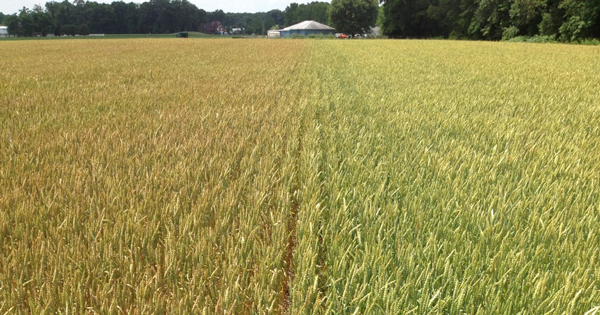


Small grains blight
September 14, 2017
UD Cooperative Extension teams with University of Maryland Extension to assess disease resistance in small grains
With over 105,000 acres of small grain crops planted in Delaware in 2016, at a value of $24 million, it is vital to keep the industry up to date on the latest developments in disease resistance.
One disease of particular interest is Fusarium head blight (FHB), considered the most damaging pathogen of small grains worldwide that reduces yields of wheat and barley and also contaminates grain with the carcinogenic mycotoxin known as deoxynivalenol (DON).
To help area growers, the University of Delaware’s Cooperative Extension Field Crop Pathology team has joined with a group from the University of Maryland to look at varieties of small grains with moderate resistance to FHB and DON.
Using a misted nursery, in which plants get mist irrigated every night by a sprinkler system, located at the University of Maryland’s Beltsville facility, the group assessed 57 wheat varieties for FHB and DON in 2017, collecting data and sharing that data online, as handouts at meetings and as mailers to growers in Delaware and Maryland.
From UD’s prospective, the study was led by Nathan Kleczewski, extension field crops plant pathologist, who said mist irrigating the different varieties every night allows the disease to develop more consistently, enabling the researchers to provide more consistent and reliable measures of FHB and DON resistance.

“You might have two varieties,” said Kleczewski. “Variety one might flower on Monday and variety two might flower on Friday. Now, if you get heavy rains on Monday and it is dry for the next several days or weeks, you may come back later and think, ‘Variety two is resistant to FHB.’ In reality, the environment was not conducive for disease, that’s why symptoms were not present on variety two.”
The researchers are evaluating commercial varieties and some varieties that haven’t been released yet to see which ones have the best resistance to head blight and DON.
“What we’re able to do is provide the growers with a nice, unbiased evaluation of the different varieties for head blight,” said Kleczewski, who noted that different companies sometimes use different standards when they rate their varieties for diseases. "We compare everything across the board and we line up the varieties where they are relative to one another, not just within the company."
The idea of the misted nursery research is to try and promote the utilization of newer varieties of wheat that have more resistance to FHB with the end result being that growers in the region will suffer fewer losses to head blight and DON.
“In the end, grain prices might go up because there will be less mycotoxin contamination, maybe we can minimize the amount of pesticides that are going on the plants and improve the profitability of the growers, the millers and everybody in the whole chain,” said Kleczewski.
Head Blight
Kleczewski said that FHB is a fungal disease that grows mostly on corn residue. Around Delaware and in the Chesapeake Bay area, there is a lot of no-till agriculture, which means that crops are planted onto residue and not tilled or buried material.
Wheat is usually planted after corn resulting in left over corn residue on fields which can be used as a food source for FHB. The pathogen overwinters on corn and in the spring, when the wheat starts to flower, spores are produced on the corn and can infect the heads of wheat during wet rainy periods.
“When the pathogen infects the head, it can cause yield loss because it chokes off the water and nutrient movement to the grain so that the grains aren’t as big, they don’t fill up with sugars as nicely, and they lose quality,” said Kleczewski.
The fungus can also produce a toxin, such as DON, and that toxin can deceive growers into thinking that their crop is good because it doesn’t appear to have head blight but it could be susceptible to accumulation of the toxins.
“We screen not just for visual symptoms but also for the mycotoxin,” Kleczewski said. “If our grain buyers here in Delaware buy a lot of wheat with a lot of mycotoxin, they can’t sell it to the people in Pennsylvania where they need to sell it so what they end up doing is bringing in grain from areas like Brazil or Canada and that costs them money. When they have to do that, it also lowers the price of wheat for our growers and so we want to try and minimize the amount of mycotoxin in our grain to really help everybody out in the long run.”
UD worked with Jason Wight, assistant research scientist at the University of Maryland, and the Variety Trials team at the University of Maryland on the project.
The Maryland team plants, maintains and harvests the plots. Kleczewski’s group inoculates the site with corn infested with the FHB pathogen, rates the varieties, and evaluates FHB and DON data.
For information on the researcher’s findings, visit Kleczewski’s website and Scabsmart. The data can also be found on the small grain variety trials website run out of the University of Maryland.
Contact Us
Have a UDaily story idea?
Contact us at ocm@udel.edu
Members of the press
Contact us at 302-831-NEWS or visit the Media Relations website

